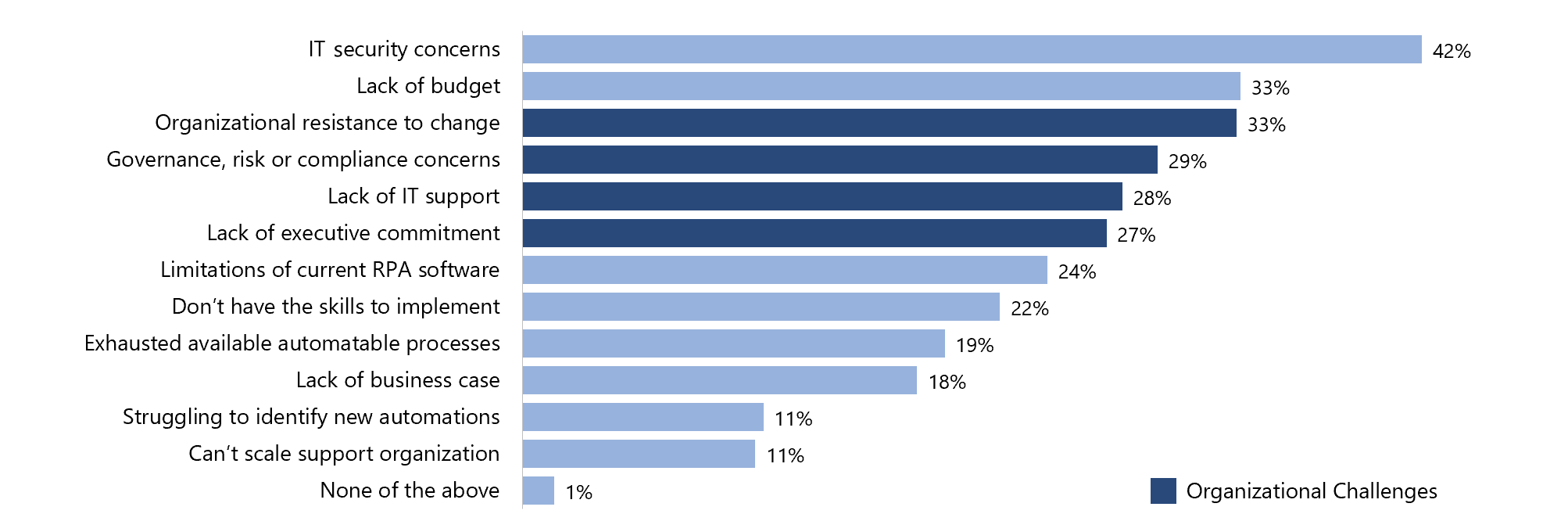IT Often Responsible for RPA Buying Decisions
ISG Research conducted a survey of 549 European business leaders to assess their adoption of robotic process automation (RPA) technology and services. Here we explore the role IT is playing in RPA decision-making. Future posts will cover other notable findings.
The results of the ISG RPA survey in EMEA show that the CIO is responsible or accountable for the RPA buying decision 81 percent of the time (Figure 1).
Figure 1: RPA Buying Decisions: Who’s Responsible?

Source: ISG Research 2018 Q1 EMEA RPA Study, n = 549. Remaining percentages – not selected.
As a standalone finding, this may seem to corroborate an already known fact. But let’s look at it in conjunction with another finding from the survey – 57 percent of organizations cite “Lack of IT support” and “Governance/compliance” as organizational challenges that pose a significant long-term barrier to RPA adoption (Figure 2).
Figure 2: Long-Term Barriers to RPA Adoption

Source: ISG Research 2018 Q1 EMEA RPA Study, n = 549
This apparent contradiction of CIO and CFO buying responsibility but organizational challenges as barriers to RPA adoption are important because, if you consider automation a team sport, both the business side and the IT organization must play together to advance the ball.
Skepticism in the Business or IT Will Only Impede Growth
While CIOs often are held accountable for buying decisions related to RPA, they do not always have the final say when it comes to implementing RPA projects. In many cases, CFOs, CoE Heads and Shared Services Leaders own their automation programs without IT’s participation.
Enterprises often consider RPA tools intuitive technology that can enable business users to automate processes without significant IT involvement. But this doesn’t take into account the fact that RPA is not a plug-and-play capability; it requires people with technical and business skills to plan, develop, deploy and manage it.
While RPA can enable process automation in a nondisruptive manner and avoid IT involvement, deploying RPA without informing IT can lead to unexpected challenges related to security and resilience/recovery. For instance, according to the ISG Survey, respondents across EMEA claim IT security as the most significant barrier to RPA growth in an organization (Figure 2).
Effective RPA Governance Depends on Collaboration of Business and IT Teams
The IT team needs to play the role of a strategic partner that enables organizations to exploit the transformative power of RPA. Successful implementation requires a balanced approach that encourages consistent communication and collaboration between IT and the business. IT can add value by addressing potential integration issues of RPA with existing programs.
The CIO-led IT team needs to take a long-term, strategic approach to RPA success. It also needs to widen its lens so that it architects holistic solutions to change the way an organization operates. CIOs can create agile teams of digital experts to support RPA implementations that scale across the enterprise. Doing so will help IT move from merely influencing RPA buying decisions to ensuring positive outcomes from the automation projects themselves.
Join ISG experts and your enterprise peers at the ISG Automation Summit in New York, July 18-19, where we’ll discuss how automation is changing the way we live and work.
About the author
Aparna has over ten years of experience researching and writing on the impact of digital transformation on customer experience, operations, people and culture. Her work has involved conducting in-depth research and data analysis focused on identifying future trends, key challenges and building business cases to develop differentiated frameworks that help clients profitably grow their businesses.

